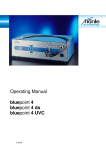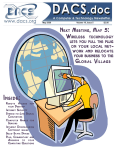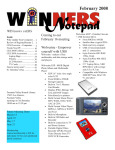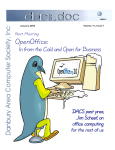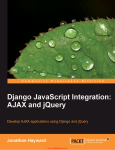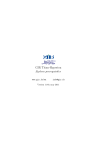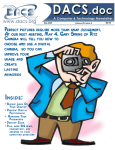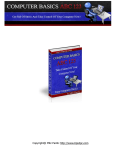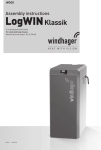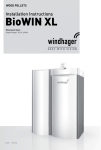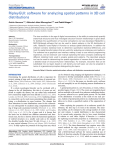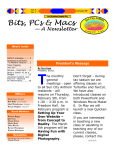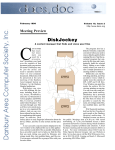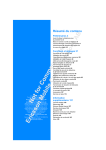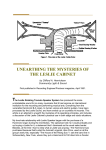Download the All-Entangling Internet All-Entangling Internet All
Transcript
January 2008 Volume 19, Issue 1 Next Meeting: 0 . 2 b e W the All-Entangling Internet President’s File OK, though, as I’m sure I’ll be ready to return home midway into the week anyhow. Happy N e w Year! f your Holidays were anything like ours, then you ate too much, gave too much, and probably got too many goodies. This year we didn’t travel as we had in the past, which allowed for much desired and appreciated ‘down time’. As long as everything was enjoyable, then that’s all that really matters! To kick off the year, I’ll be attending the 2008 APCUG Annual Convention being held January 3 through January 6 in Las Vegas. DACS is a member of the Association of Personal Computer User Groups. Being able to rub elbows with members of other Computer User Groups from around the world should be quite interesting and educational. DACS was also entered in the Newsletter and Website competitions by a couple of our members. The 2008 Consumer Electronics Show begins the day after the APCUG convention ends, so I’m revved up to attend that, too. Since I’ll already be in Vegas, I’ll get to see both shows! Unfortunately, my stay will be cut too short to be there the full week. That’s More books First up is “A Brief History of Time” by Stephen Hawking. This was a surprisingly longer read than I had anticipated. For the uninitiated, this book discusses the relativity and quantum theories. The first few chapters were reasonably easy to keep up with, but then the book got a little tougher. Mr. Hawking uses very plain and simple-to-understand language. The complexity is within the ideas and thoughts conveyed in the book. Interestingly enough, the book does spend a fair amount discussing theology—which I didn’t really expect. Overall, this was a great book, but it did require extra time to reread some paragraphs to ensure the point conveyed was understood. Thankfully this isn’t a thick book! Next in my pile of reading material was “Leonardo’s Lost Robots” by Mark Elling Rosheim. DaVinci created many masterpieces, with which we are all familiar, throughout his life. Arguably, one of the most recognized items is the “Last Supper”. Leonardo’s work on mechanical devices and anatomy led him to work with ‘automaton’ designs. This book takes you through Rosheim’s research and intrigue trying to compile and recreate Leonardo’s work. My favorite designs in the book were the programmable cart, the knight, and the hydraulic computer used in the bell ringer design. It’s amazing to see what was capable even in such early times! I IN THIS ISSUE PRESIDENT’S FILE 2 DIRECTORS’ NOTES 3 HELP LINE 3 PREVIEW - WEB 2.0 4 REVIEW - JOHN PATRICK 4 REINVENTING DACS 5 TWEAK YOUR PC 6 SIG NEWS & NOTES 8 CALENDAR 9 SIGNIFICANT BITS 10 BUCKY MILAM CARTOON 10 CIRCUIT RIDER 11 ONE LAPTOP PER CHILD 12 REMEMBERING JAMIE 13 SAITEK OPTICAL PHOTO MOUSE 13 ASK DACS 15 2 • January 2008 A Quick Reminder Our 2008 General Meeting Schedule is changed for the first six months of 2008. Our General Meetings will be held on the FIRST MONDAY of January through June 2008. The ‘FIRST TUESDAY’ schedule will resume July 2008. K ee ping it shor t… eeping Due to the recent Holidays mentioned above, this is being written smack-dab between Thanksgiving and Christmas. It’s difficult to stop and take a look at everything going on, so I have little else to report. Until next time… —Rob Limbaugh [email protected] Membership Infor mation dacs.doc, ISSN 1084-6573, is published monthly by the Danbury Area Computer Society, 4 Gregory Street, Danbury, CT 068104430. Annual subscription rates: $45 to regular members, $30 electronic access (included in dues). Postmaster Send address changes to Danbury Area Computer Society, Inc., 4 Gregory Street, Danbury, CT 06810-4430. Editorial Committee Managing Editor: Production Editor: Copy Editor: Patrick Libert Marc Cohen Patrick Libert Contributors Charles Bovaird Sean Henderson John Lansdale Chris Novell Jeff Setaro Richard Corzo Mike Kaltschnee Lisa Leifels Jim Scheef Richard Ten Dyke DACS, its officers and directors assume no liability for damages arising out of the publication or non-publication of any article, advertisement, or other item in this newsletter . The editors welcome submissions from DACS members. Contact Patrick Libert at 860-567-9586 ([email protected]. Advertisers, contact Charles Bovaird at (203) 792-7881 ([email protected]) Nonprofit groups may request permission to reprint articles from dacs.doc or http://dacs.org by sending e-mail to [email protected]. Reprinted articles shall credit the copyright holder and a copy of the final publication shall be mailed to: Danbury Area Computer Society, Inc. 4 Gregory Street Danbury CT 06811-4403 Attn. Reprints Links to articles reprinted on the web can be sent to: [email protected] Tec hnical Suppor t echnical dacs.doc is prepared using PageMaker 7.0 and Acrobat 7.0.Software packages used to publish dacs.doc include: Microsoft Windows XP, Office 2003, TrueType fonts, Calendar Creator 8.0 for Windows. Internet access provided by Mags.net Applications & Hardware to enhance dacs.doc are welcome. Patrick Libert APCUG Liaison [email protected] http://www.dacs.org Officers Directors’ Notes PRESIDENT: Rob Limbaugh (203) 648-9176 [email protected] Vice Presidents: Chris Novell, Sean Henderson SECRETARY: Lisa Leifels • TREASURER: Charles Bovaird Directors [email protected] Charles Bovaird Howard Berger Annette Collens Richard Corzo John Gallichotte Sean Henderson John Lansdale Patrick Libert Rob Limbaugh Jim Scheef Jeff Setaro (203) (860) (914) (203) (203) (203) (914) (860) (203) (860) (203) 792-7881 355-9837 232-0149 797-1518 426-0394 837-7068 533-2002 567-9586 648-9176 355-0034 748-6748 [email protected] [email protected] [email protected] [email protected] [email protected] [email protected] [email protected] [email protected], [email protected] [email protected] [email protected] Committees NEWSLETTER: Patrick Libert: [email protected], (860) 567-9586 PROGRAM: Chris Novell ([email protected]) WEB MASTER: Richard Corzo ([email protected]), (203)797-1518 Annette Collens ([email protected]), (914)232-0149 MARKETING AND PR: Sean Henderson ([email protected]) APCUG LIAISON: Patrick Libert ([email protected]) RESOURCE CENTER: (203) 748-4330 • WEB SITE: http://www.dacs.org HelpLine Volunteers have offered to field member questions by phone. Please limit calls to the hours indicated below. Days means 9 a.m. to 5 p.m.; evening means 6 to 9:30 p.m. Please be considerate of the volunteer you are calling. HelpLine is a free service. If you are asked to pay for help or are solicited for sales, please contact the dacs.doc editor; the person requesting payment will be deleted from the listing. Can we add your name to the volunteer listing? d = day e = evening Program Name Phone APL Charles Bovaird (203) 792-7881 # ( e) ASP.Net Chuck Fizer (203) 798-9996 (d ) C/UNIX/ObjC Kenneth Lerman (203) 426-4430 (d e) C#, VB Chuck Fizer (203) 798-9996 (d ) DOS John Gallichotte (203) 426-0394 (d e) Electronics Andrew Woodruff (203) 798-2000 (d e) Hardware John Gallichotte (203) 426-0394 (d e) Interface-Instrumentation Andrew Woodruff (203) 798-2000 (d e) PhotoShop/Dreamweaver Anna Collens (914) 232-0149 ( e) SAS Lewis Westfall (203) 790-0229 ( e) Statistics/Data Analysis Charles Bovaird (203) 792-7881 (d e) SQL Lewis Westfall (203) 790-0229 ( e) SQL Server, MySQL-5 Chuck Fizer (203) 798-9996 (d ) Malware Jeff Setaro (203) 748-6748 (d ) VB.Net, Visual Basic Chuck Fizer (203) 798-9996 (d ) http://www.dacs.org T he Board of Directors meeting was held on Monday, December 10, 2007. Present were Charles Bovaird, Howard Berger, Anna Collens, Richard Corzo, Sean Henderson, John Lansdale, Lisa Leifels, Patrick Libert, Rob Limbaugh, Christine Novell and Jeff Setaro. President Rob Limbaugh presided and secretary Lisa Leifels kept the record. Minutes of the last meeting held November 12, 2007, were approved. Treasurer Charles Bovaird reported current cash assets of $8,628.04, consisting of total bank and postal accounts in the amount of $8,596.14 plus postage on hand of $31.90. Subtracting a liability of prepaid dues in the amount of $4,698.00 left a net equity of $3,930.04. In January Web 2.0 will be the featured presentation done by Jim Scheef, John Lansdale and Chris Novell. In March the topic will be IT Solutions for Non-Profits and ‘Secure Computing in the Internet Age’ is coming up in April. Network Support Solutions expressed interest in doing a Citrix presentation in May. Mike Kaltschnee offered to give a talk on IPTV Home Theater later in 2008. Chris summarized the preliminary survey results for future meeting topics. Digital Photography, PC Armor, HDTV, Remote Access and Mobile Devices were five subjects that people expressed interest in. Rob offered to scan in the surveys and convert them into a PDF format. Sean Henderson suggested the idea of putting together a thank you package to be given to the people who present at the general meetings. Howie Berger plans to attend a meeting with the Greater Danbury Nonprofit Resource Center (GDNRC) in Danbury on Friday, December 14. He would like to get more information on local projects that DACS can get involved with. Rob mentioned that he will get in touch with Dick Gingrich, who was the DACS President when the membership was at the highest point. He is hoping to get some ideas from him on how we can increase the membership. The six board members elected at the December 2007 General Meeting include Howard Berger, Anna Collens, Sean Henderson Rob Limbaugh, Jim Scheef and Jeff Setaro. All are incumbents except for Anna Collens, who has replaced Lisa Leifels. —LISA LEIFELS, SECRETARY January 2008 • 3 Meeting Review The Future of the Internet December 2007 By Chris Novell F OR THE SIXTEENTH consecutive year, John Patrick, President of Attitude LLC and former vice president of Internet Technology at IBM, delivered a speech on the future of the Internet, both informing and entertaining the audience of both members and guests. The well attended event has been a staple of the DACS program calendar, a presentation containing insights and perspectives gathered by Mr. Patrick from a myriad of international sources. Indeed, he relayed to the audience that at a conference recently, someone had remarked that his placement of the current Internet at 5% of its potential was perhaps even too high! There were several contributors to the Internet that got high marks from Mr. Patrick. eBay was cited for its careful attention to their process from end to end, or, as he refined, from beginning to end. Escrow, shipping, taxes, terms and conditions, recourses, and reputation are just some of the details the company addresses. The federal government received recognition for its early leadership and innovation with the availability of e-filing tax returns, and the huge gaming industry was named as contributing to the development of certain practical skills such as learning how to collaborate and communicate. Universities are realizing that it makes sense to enable students to retain their email addresses on a permanent basis. Danbury Hospital now uses a Smart Card, eliminating the need for the clipboard sign-in sheet. Noting that Nintendo’s Wii has a browser, Mr. Patrick described what many of us may have had as a transient thought: the PC is becoming a minority player! He Meeting Preview Web 2.0 By Chris Novell A CONVERSATION THAT may have taken place between two membersofDACS, Wondering William (WW), and Fact Finding Francine (FFF) WW: So what’s on tap for January at DACS, Francine? FFF: I hear they’re going to be talking about Web 2.0. WW: I was hoping to learn more about it. My boss asked the other day and I had no idea. I find stuff on the web I still don’t know exactly what it is. Can I use it? Do you need some special browser or computer program? Is it just stuff my kids use like MySpace and YouTube? 4 • January 2008 FFF: The way I’m hearing it, there could be something for just about anyone… remember Chris Novell’s talk a few months ago on social bookmark-ing, that del.icio.us site. I’ve got my own account I use for work and there’s one she set up for us at http:// del.icio.us/dacsorg/ that was a good idea. WW: Maybe we could learn more about Web 2.0 there. FFF: I bet, and we can add some of our own. That’s the idea. WW: So who is going to give the talk? FF: Chris has found some more good examples of Web 2.0 and is going to show us. SIG leader John Lansdale is a sees the hand held category as continuing to gain prominence. Mr. Patrick expressed his belief that U.S. corporations are not responsive enough to the modern commerce constellation: customers are expecting a 24/7 online marketplace that offers choices rather than barriers. He also pointed out some cultural differences that have occurred. Most adults in Europe and Asia readily send and receive text messages on their cell phones, whereas American adults are not so inclined, and Asians commonly make use of vascular scans, a biometric technology that does not require any actual contact. The Internet continues to expand the reach of people everywhere, Mr. Patrick commented. Linux is changing the game, to a situation where if there is a problem that needs an answer, a person can turn to the community. Home schooling, which used to take place in the home, can now take place online as well. Mr. Patrick believes that there can be adequate policies to provide for privacy. He also favors the structures that are needed for safeguards to be provided by technology, rather than by laws. As an example, he referenced the “Do not call” legislation that is burdened with 19 exceptions. In closing, Mr. Patrick reiterated the trend for people to be empowered by the Internet. He recommended getting some pointers from kids. Oh, and yes, his website, patrickWeb is written using OpenOffice. CHRIS NOVELL is DACS program director, and an avid Web crawler. Web application developer and he is going to talk about it from the inside. Stuff about the business model, some of the technologies and maybe more examples. WW: I heard Jim Scheef’s going to talk? FFF: Yeah, and as usual he’s got something cool to show us. It’s a Web 2.0 application called ZohoWriter and something about the storage aspect. He always teaches us something we can use. WW: I’m bringing my notepad. Got a feeling there’s going to be some links to remember. FFF: Me too. And you know, I think I’m going to start some research myself, come up with a few good links of my own. I hear they’re going to ask for some ideas from the floor. WW: Hey, thanks, Francine, I’m going to start making a list. Wondering William and Fact Finding Francine will be coming to the DACS January General Meeting to learn more about Web 2.0 – come join them! PREVIEW, Continued on page 5 http://www.dacs.org Preview, CONTINUED Reinventing DACS Let’s Shake Things Up a Bit By Mike Kaltschnee I ’VE BEEN INVOLVED with DACS for about 20 years now, and it really hasn’t changed much. I think it’s time that we reinvent the organization. It’s disheartening to see the membership dwindle to less than 300, when we had close to 1,000 a few years ago (more than 500 people attended the Windows 95 launch). DACS has a lot to offer the community, and when almost every household has a computer, they must need help, advice, and information. It might be time to rethink the structure of the ge n e r a l m e e t i n g . We get the majority of people to attend only one night per month, and instead of a Q&A session we might want to have two or more presentations, with mini-SIG meetings as well. The first presentation could be a demo from a member on something about which they are passionate. I understand that one of the highestattended meetings recently was a member demo, and we could have one every month. By having two presentations we could double the odds of the meeting being of interest to someone. Another possibility is that instead of a Q&A, we would break up into groups to discuss different topics. SIG leaders could hold up signs for Linux, Newbies, Q&A, Mac, etc, and they could have mini-meetings in different sections of the auditorium. This would be great way to expose new members to the different SIGs, and give people a chance to participate. The following is one way we might structure the general meeting: 7:00 Club business 7:15 First presentation 8:00 Mini-SIG meetings 8:30 Break 8:45 Main presentation 9:45 Closing and raffle http://www.dacs.org The current meeting structure does not allow for socializing, something I look forward to at the Pig Sig. The problem is that only a handful of people show up, and I wonder if one of the reasons we are unable to retain members is that they don’t see DACS as a social club. Are we missing out on the bonding and friendships that develop if people can mingle and network? I hate to say it, but I think the resource center is holding us back. Yes, it’s an incredible bargain, but I know some people don’t feel safe on Main Street Danbury at 9:30 p.m. It’s small, and there is limited parking. What if we had our own building? Why not? Look around Danbury and you’ll find a train museum, military museum, PAL center, Elks lodge, and a multimillion dollar Portuguese community center. Why not raise funds for our own building? While we’re dreaming, why not combine it with a computer museum? How would we fund these bold dreams? There are many corporations in the area (Duracell, IBM, etc.), and we should look to see how the Portuguese funded such an amazing facility. Imagine the things we could do if we had our own building. We could build a computer lab that was open to the public, host training classes, special events, SIG meetings, and much more. Geeks need a place to socialize, just like the Masons, Elks, Lions, and the Rotary. I hope that this article doesn’t upset anyone, especially the people that have put years into building DACS into the great organization that it is now. My hope is to spark a discussion that will help grow DACS into something new and wonderful. Let’s dream big, and make DACS into an amazing organization. Mike is a local entrepreneur who loves to hang out with geeks and newbies, and he blogs at hackingnetflix.com FROM PAGE 4 DACS meetings are held at the Danbury Hospital auditorium. Activities begin at 6:30 p.m. with registration and casual networking. The meeting starts at 7:00 p.m. The featured evening presentation begins at 8:00. Our General Meetings are free and open to the public so invite anyone you know who would be interested in this topic. CHRIS NOVELL is DACS program director, and an avid Web crawler. STATEMENT OF OWNERSHIP, MANAGEMENT AND CIRCULATION (required by 39 U.S.C. sec. 3685) DACS.DOC, ISSN 1084_6573 is published monthly at 4 Gregory Street, Danbury, CT 6810-7271. The filing date of this Statement is December 1, 2007. Annual subscription price is $45.00. Complete mailing address for known office of publication is 4 Gregory Street, Danbury, CT 06810-7271. Names and addresses of Publisher, Editor and Managing Editor are: Publisher, Danbury Area Computer Society, Inc., 4 Gregory Street, Danbury, CT 06810-7271; Editor and Managing Editor, Patrick Libert, 222 Maple Street, Litchfield, CT 06759 Owner is Danbury Area Computer Society, Inc., 4 Gregory Street, Danbury, CT 068107271. Known bondholders, mortgagees and other security holders owning or holding 1 percent or more of the total amount of bonds, mortgages or other securities are: None. The purpose, function, and nonprofit status of this organization and the exempt status for federal income tax purposes has not changed during the preceding 12 months. Be Informed by E-mail Members who wish to receive DACS email messages who have not received an email notice for the General Meeting should send a request to be put on the DACS email list to: treasurer @dacs.org. January 2008 • 5 Tips & Tricks Tweak Your PC to Keep It Running Fast, Feeling Good and Looking Young! By Lou Torraca L AST WEEK, I WAS explaining to a friend that I am a quick launch toolbar afficionado. What the heck is that he asked. I said I was just referring to the fact I use it instead of the desktop to keep all my shortcuts, actually, lots of shortcuts, at least on my main PC. As we continued to talk about this I found myself explaining a lot of stuff I have done with my PCs and notebook in the past 6 or 8 years! An obvious question came up: “where do you come up with these things?” At that point I explained I call these “things…tweaks” and they come from dozens and dozens of places including many newsletters, also some regular blogs, newspapers, radio shows, other PC users I talk with and of course, the real biggie, MICROSOFT! Yup, their knowledge base contains millions of tips, solutions and you guessed it…TWEAKS! Our conversation ended with a suggestion that I put some “tweaks” in my column, so what follows are some that I like. But first, a reminder, whenever you decide to play, experiment, alter, or as I say, “tweak” an otherwise functioning computer, either do a backup first, or at least, set a restore point you can return to if what you do doesn’t work out for you. If you don’t know how to do that, click on start and then help and support and then choose index and type in system restore. At the end of this list, I have a couple speed tweaks which I advise should only be used by advanced users, and you will also see I advise again to backup or set a restore point. With that in mind, here is my list. QUICK LAUNCH The area that sits between the start button and the tray (with the clock), on the bottom of your screen, is called the Taskbar. I think one of the best additions you can make to your Taskbar is the Quick Launch Toolbar. Quick Launch gives you fast access to Internet Explorer and Outlook Express, and it includes a Show Desktop icon. It’s really easy to open your Quick Launch Toolbar. 6 • January 2008 Right-click the Taskbar, click on Toolbars, and choose Quick Launch. The Quick Launch Toolbar now appears on your Taskbar right next to your Start button. You’ll find the Quick Launch Toolbar very useful and to move all the icons you have on your desktop, just drag and drop them on the QL taskbar. You can play around with it and also expand it if need be. After you drag an icon there, you can delete it off your desktop so you have a neat looking space where I put different pictures every week or so. To be really neat, I hide the whole thing so it automatically disappears until I Point at it with my mouse. Right click on start, properties, taskbar and check auto hide. If you can copy or move things to a folder, keeping information on your computer more organized is easier. Here is how to add copy or move to a folder to Windows Explorer. Open Windows Explorer (not Internet Explorer) by clicking on Start and then on My Documents. Next, click on an empty area of the standard button bar, the one that starts with the Back button. Last, click on customize. In the available toolbar buttons: list, click on copy to and then click on add to add it to the current toolbar buttons list. Click on Close to complete the customization work. Now the next time you click on a file or folder, the Move to and Copy to folder buttons will appear If you ever have the need to copy both files and folders to a CD, as in backing up your important information, here’s an easy way to do it. Click on Start, and then click on My Computer. Now rightclick on your hard drive (usually drive c:) and click on Explore. Now you have a complete list of the files and folders on that drive. Click on any file or folder, and then, while holding down the Ctrl key, click on any other file or folder you wish to copy to a CD/DVD. When you have finished, click on edit, copy to folder. From the list provided click on the CD/ DVD R/W (Read/ Write) drive you want to send your selection to, and then click Copy at the bottom of that small window. This will result in a folder with those items waiting to be copied. Put in a CD/ DVD and click on write these files to CD to the left. Windows XP has several utilities programs that manage various aspects of XP. You can run any of these utilities by using them as “run” commands. Click on Start, and then click on Run. In the Open: box, type one of these shortcuts and press the Enter key or click OK. control Opens Control Panel clipbrd Opens Clipboard Viewer notepad Opens simple text editor wordpad Opens Word-like text editor compmgmt.msc Computer management devmgmt.msc Device manager diskmgmt.msc Disk management dfg.msc Disk defrag eventvwr.msc Event viewer fsmgmt.msc Shared folders gpedit.msc Group policies lusrmgr.msc Local users and group perfmon.msc Performance monitor rsop.msc Resultant set of policies secpol.msc Local security settings services.msc Services. (Run shows up when you have classic menu selected.) MY COMPUTER I use My Computer, which shows me all of the drives on my computer, like the floppy drive (A:), the Hard Drive (C:), and others that include DVD and CD drives and removable drives, all the time. Having My Computer show a menu of it’s items as your mouse pointer touches the My Computer link on the start menu is a quick way to get to what you want. To set this up, right-click on the start button, and then click on properties. Click on the customize button and then open the advanced tab. In the start menu items window, scroll down to my computer, and click next to http://www.dacs.org display as a menu. Now click on OK, and again on OK. (This one is the opposite of the one above in that you need to select start menu instead of classic.) TRAY That little area to the right at the bottom of your desktop can get pretty crowded. One way to get more space is to do away with the clock. You can eliminate the clock by right clicking on any blank section of the Task bar, and then clicking on Properties. On the Taskbar tab, click on the checkmark next to “Show the clock” and finally click OK. You can also check the hide inactive icons box to gain a bit more space. When you click on Start and open My Computer, you have to right-click on a drive and then click Explore to get the “Explore” view of that drive. If you simply double-click on that drive, you get the drive’s contents. The Explore view is better because you can work with folders in the left pane and folder contents in the right pane. To have My Computer open the contents of a drive in the Explore view, from within My Computer click on Tools and then on Folder Options. Open the File Types tab and then click on (NONE) Folder, to highlight it. Now click on the Advanced button, make sure Explore is highlighted, and then click the Set Default button. Click OK, and then click Close. Now when you open a drive in My Computer it will display in the Explore mode. Your my documents folder in windows XP holds, by default, your documents, the My Pictures folder and the My Music folder. For most of us, the My Documents folder holds everything you use most. To make the contents of that folder invisible to nosy folks, do this: Click on Start and right-click on My Documents. Now click on Properties, and then open the General tab. Click in the box next to Hidden in the attributes section and click ok. Now click on Apply, Select “Apply changes to this folder, subfolders and files,” and click ok. This is not encryption, it just makes it harder for a casual user to open your private folders. When you want to view all files again, just reverse the process. Speeding up your PC is always something most of us think about and the folhttp://www.dacs.org lowing tweaks are intended to do just that for your XP Pro operating system, but beware, these are intended for advanced users and involve using the registry…not recommended for the faint at heart! Before even considering them, do a registry backupHere’s how: Modification of Windows Registry files, which contain settings and other information Windows needs to operate with is risky if you don’t take care. Make a mistake here can cause your PC to stop working. So it makes perfect sense to make a back-up copy of your registry files before you attempt any modifications. Create a batch file to back up your Registry, and then automate the process with an icon on your Desktop. Click on Start, Run, and then type NOTEPAD. Click OK or press the Enter key. Now you have Notepad open to a blank page. Type “Regedit /E C:\AAAA” (without the quotes) and press the Enter key. Now click on File on the menu bar at the top of the Notepad window, and then click on Save As. In the Save As window, click in the box next to File Name: and type c:\windows\system32\REGBACKUP.BAT. Now click on the down arrow to the right of the Save as type: box and select All Files. Click on the Save button, and close Notepad. To create a shortcut to the registry backup, right-click on the Desktop, click on New and then on Shortcut. At the cursor type c:\WINDOWS\SYSTEM32\ REGBACKUP.BAT and click on Next. Now type: Registry Backup and click on Finish. If you want to change the icon for your new shortcut, right- click on it and click Preferences. Click on the Change Icon button, click Ok when the Change Icon window opens, and then double-click on the icon you want to use. Click OK Another way to be sure you are safe is to backup your complete computer using either True Image (my favorite) or Ghost…both of which completely copy an image of your entire computer. Also, do a system restore point (see the help menu for how to) this may be the quickest way to go back to where you were if you have problems, but if not, the True Image or Ghost backup will do the trick. HELP GRAPHIC Here’s a way to make XP even faster, by making sure that Operating System functions stay in memory (RAM), because memory is much faster than your hard disk. Try this: Click on Start, on Run, and then type REGEDIT and click OK or press the Enter. The word REGEDIT is not casesensitive. Now double-click on HKEY_LOCAL_MACHINE. Drill down by opening System\CurrentControlSet\ Control\Session Manager\Memory Management. Right-click on the DisablePaging Executive entry located in the right pane (side) of your screen and select Modify. In the Edit DWORD Value dialog box, type the number “1” (without the quotes) in the Value data field. Click OK and then close the Registry Editor. Finally, make sure you don’t have any open programs, and restart your computer so that the change you made can take effect. Lastly, it seems that our Windows XP computers just get bogged down with stuff we don’t want or use. One way to get more performance out of your computer is to disable the “last access/update” feature. The NTFS file system in Windows XP maintains last access/update details for each file and directory on your computer’s hard drive. This information is useful sometimes but for most of us, this may not be of much use most of the time. This process takes a lot of resources from your computer, so it may make sense to disable it. Once you have done that, you’ll still have access to last modified information for files and folders. Here’s what you need to do. Click on Start, Run, and at the prompt type REGEDIT and press the Enter key. Now click to open HKEY_LOCAL_MACHINE, and then drill Tweaking, Cont. on page 15 January 2008 • 7 Special Interest Groups SIG NOTES: October 2007 ASP.Net. Focuses on Web site/server application development using Microsoft Visual Studio, C#, VB, Javascript and SQL Server programming tools. Starts with Random Access, followed by a programming discussion with examples. Contact: Chuck Fizer [email protected]. Meets 1st Wednesday, 4-6 p.m., at the DACS Resource Center. Next Meeting: January 2 Digital Imaging. Digital cameras, retouching and printing. Contact: Ken Graff at 203 775-6667 [email protected]. Meets last Wednesday, 7 p.m.at the DACS Resource Center. Next Meeting: April 30 Investment Strategies. Discusses various investment strategies to maximize profits and limit risk. Contact: Paul Gehrett, 203 426-8436, [email protected]. Meets 3rd Thursday, 7:30 p.m., Edmond Town Hall, Newtown. Next Meeting: January17 Jobs. Networking and jobs search Contact: Charles Bovaird, 203-792-7881 [email protected]. Meets by e-mail. Next meeting: TBA Linux. Provides Help in installing and maintaining the Linux operating system. Also of interest to Apple owners using OS X. Contact: John Lansdale 914-533-2002 Meets 3rd Wednesday, 7:30 pm at the DACS Resource Center. Next Meeting: January 16 Macintosh. Focuses on all aspects of the Mac operating system. Contact: Richard Corzo [email protected]. Meets 1st Thursday at DACS Resource Center at 7 p.m. Next Meeting: January 3 Open Source Web Programming. Focuses on open source tools for Windows and Linux. Contact: John Lansdale, 914-533-2002. Meets 3rd Monday, 7 p.m. at the DACS Resource Center. Next Meeting: January 21. PC Maintenance. Review of PC hardware and OpSys maintenance and use. Contact: Charles Bovaird, 203-792-7881 [email protected]. Meets on 4th Thursday, 7 p.m. at the DACS Resource Center. Next meeting: January 24 Server. Explores Back Office server and client applications, including Win NT Servers and MS Outlook. Contact: Jim Scheef [email protected] Meets 2nd Thursday, 7 p.m., at the DACS Resource Center. Next meeting: January 10. Tech Projects. This SIG Will work on DACS "Online Community projects as well as other areas from practical application solutions, to brainstorming and to tweeking Commercial products. All skill levels and backgrounds are welcome. The goal is to mix, match and customize technology to fit our needs. Meets 1st Wednesday, 7p.m. at the DACS resource center. Contact: Rob Limbaugh at (203)648-9176, [email protected] Next meeting: January 9 VB.Net, Visual Basic-6. Focuses on Smart Client Windows application development using Visual Studio, VB, C# and SQL Server programming tools. Starts with a random accss session , followed by Object Oriented discussions and programming with examples. Contact: Chuck Fizer, 203 798-9996 [email protected] or Greg Austin, 845 494-5095 [email protected]. Meets 1st Wednesday, 7p.m., at the DACS Resource Center, preceeded 1 hour with a shared cost pizza snack. Next Meeting: January 2. Virtual Computing. ThisSIG will explore virtual computing technologies and how to leverage them as additional system resources. Our main focus will be on the free VMWare products, but we will also look at other technologies and tools. Meets 4th Tuesday, 7 p.m. at the DACS Resource Center Contact: Rob Limbaugh [email protected], 203 648-9176 Next Meeting: January 22. Web Design. Applications for designing and creating Web sites. Contact: Anna Collens [email protected]. Meets 3rd Tuesday, 7-9 p.m. at the DACS Resource Center. Next Meeting: February 19. Windows. This SIG will discuss ways to get the most out of your system and applications, how to do new things, ans other options in terms of hardware and softwareto help male life easier. All skill levels are welcomed and encouraged to attend Contact: Rob Limbough [email protected], (203 )648-9176 Next Meeting: January 17. SIG News & Events ASP.Net and C#VB.Net. Our lively session launched with a good collection of random questions on code for Jscript in code for Web pages. For inline code, a block of Jscript can be identified in HTML with a script tag. A block of Jscript code that is outside the stream of HTML can be brought in with a load source command much like an image file is added. With a shift of topic to workings of Visual Studio for coding C#, we identified the elements of this Integrated Development Environment (IDE) such as Designer, Toolbar, Properties and Solution Explorer. Chuck emphasized that the 2005 version is much better than prior versions, and the 2008 version cor- rects 2005 flaws for an even better performance. Many details were illuminated to promote learning for C# coding. Refreshed with a pizza break, we were treated by Chuck to an extended illustration of application development where a month count in an interval between dates is given. With this illustration in hand, we were then able to learn the nature and use of constituents in a C# program. For example, an assembly is not exactly like a Dynamic Link Library (DLL) because it is in Intermediate Language. An assembly is read with a reflection class in which a coder can examine types, an issue of SIG NEWS,Continued on page 12 8 • January 2008 http://www.dacs.org January 2008 Danbury Area Computer Society Sunday S 2 9 16 23 30 6 M Monday Dec 2007 T W T Tuesday 1 Wednesday 2 S 1 3 4 5 6 7 8 10 11 12 13 14 15 17 18 19 20 21 22 24 25 26 27 28 29 31 Thursday 3 Friday Saturday 4 5 11 12 18 19 F 7 4 PM ASP.Net 7 PM C# VB.Net Chuck Fizer 203 798-9996 8 9 Macintosh 7:00 PM Richard Corzo [email protected] 10 7:00 - 9:00 PM Tech Projects Rob Limbaugh 203 826-8196 7:00 PM Server Jim Scheef 860 355-0034 7:00 P.M. GENERAL MTG 13 14 15 16 17 7 :00 PM Windows Rob Limbaugh 203 826-8196 7:30 PM Linux John Lansdale 914 533-2002 7:00 PM Board of Directors 20 21 Opensource Web Program. 7:00 PM John Lansdale 914-533-2002 27 28 22 23 Virtual Computing Rob Limbaugh 203 826-8196 29 DACS.DOC Deadline 24 25 26 7:00 PM PC Maintenance Charles Bovaird 203 792-7881 30 31 S 3 10 17 24 http://www.dacs.org M Feb 2008 T W T F S 1 2 4 5 6 7 8 9 11 12 13 14 15 16 18 19 20 21 22 23 25 26 27 28 29 January 2008 • 9 SIGNIFICANT BITS Januar y 2008 by Sean N. Henderson LIGHTWEIGHT SERVERS FOR XP HOME It is possible to run a simple HTTP server from home off Windows XP Home. If only a minimum functionality is needed, try TinyWEB. It’s possible to use CGI with TinyWEB without having to install any other language. CGI can be had using a .bat (DOS batch) file. If using a Netgear router, it’s recommended to sign up for a free Dynamic DNS account at www.dyndns.org, which is one of the dynamic IP services supported by these units. This provides a URL that will always point to the home server even if the home IP connection is dynamically assigned, which is typical. Setting up TinyWEB was trivial. Merely unzip the archive and place a shortcut in the startup folder. A good place to put the extracted files is under Program Files in a folder called TinyWEB. Then, in the same directory make a shortcut that has the target as “c:\progra~1\TinyWEB\tiny.exe [path\of\the\document\root\directory]” and the start-in folder as “C:\progra~1\TinyWEB\”. The start-in folder is where the logs will be stored. Lastly, put a shortcut to this shortcut in the startup folder for all users, so no matter who was logged in the server would be running. Another program called TinyBOX is a GUI wrapper for TinyWEB. For the purposes above, TinyBOX seemed unnecessary and it put yet another icon in the system tray, which wasn’t desired. A use for this setup could be to host a simple page or website, a test server, or to 10 • January 2008 use some simple CGI to display the IP that the home server is connected to so one can VNC into the home server. LIGHTWEIGHT REMOTE ACCESS TO XP HOME Windows XP Home does not have either an HTTP or RDP server built in, so one workaround for the RDP part is to use something like VNC. A comparative table of remote desktop servers and clients can be had on Wikipedia with some searching. TightVNC is a good choice due to its simplicity, no cost, and being lightweight. It is not secure, however, so other choices may be more appropriate if security is a primary concern. TightVNC also works with Linux, unlike some other VNC software. Installing TightVNC is simple since it comes with an installer. It’s possible to choose a password for merely viewing the remote desktop and one for full interaction with the remote desktop. Keep in mind that with VNC on Windows XP Home anyone in the same room as the computer will see what is being done remotely. This is a limitation of both VNC and Windows XP Home. The solution is to upgrade from Windows XP Home if this is not desired. CENTRALIZED MAIL LISTS Both my wife and I are fans of our PDA handhelds, and necessarily fans of Palm’s © Bucky Milam 2008 H appy New Year one and all! This will be my twelfth article for DACS.DOC. A lot has gone on in this space over 2007, including articles on PDAs, U3 drives, hard drive upgrades, music-production software, geocoding, mashups and more. Be sure to check out the DACS calendar on-line for General Meeting date changes for the first half of 2008. As noted in the August 2007 issue, the on-line calendar for DACS is the central source for events related to DACS. The January 2008 meeting topic is Web 2.0. Also, do not forget our ongoing on-line fund raising efforts at www.cafepress.com/dacsgear. Palm Desktop PIM software. It’s useful to think of this application as a prefabricated database with forms and screens, rather than just PIM software. Besides our individual instances on each of our laptops, there’s one on the main household desktop. This instance stores our mailing list used for our family newsletter and holiday cards. Using TinyWEB and TightVNC has proved to be a useful way to access that application on that machine to update these records. Palm Desktop has proven to be a good database to both store this information as well as an easy way for my wife and I to update the information. The other solution for this would possibly be to install a more powerful web and or application server, install and configure a CMS package, teach myself how to use it, then show my wife how to use it. Neither she nor I have time for such an activity, especially when we both already know how to work the Palm Desktop. Sean N. Henderson Is an IT professional musician, DACS.ORG board member and regular contributor to dacs.doc. FREE CLASSIFIEDS DACS members may publish noncommercial, computer-related classified ads in dacs.doc at no charge. Ads may be sent by e-mail to Charlie Bovaird at aam@mags. net, or hard-copy may be submitted at our monthly general meeting. "You should have waited until after Christmas to give them the computer games" http://www.dacs.org Circuit Writer Version 5.5 by Jim Scheef T he name of my column changes slightly this month. The reason for the change will become apparent at the end. A T aste of A r ma g ed don In Star Trek episode 23, two planets wage war by computer. Each planet plans their attacks and countermeasures in a computer (a large box with blinking lights, of course). The computers then determine an outcome using what we now call a simulation. When the results of an attack are determined, the “casualties” – anyone in a region “destroyed” in the simulation – voluntarily go to a center of some sort where they are executed. Since we have yet to make any (known) interstellar enemies, for now, we need only worry about cyber warfare with other countries here on Earth. Do you think this is rather far fetched? I have a hard time imagining that people would voluntarily agree to be executed, and so did Captain Kirk. Gen. James Cartwright, of the U.S. Strategic Command, is quoted in an eWeek article (http://tinyurl.com/yqzfk5) that China is already actively engaging in cyber-reconnaissance through the probing of the computer networks of U.S. government agencies and private companies. “I think that we should start to consider that regret factors associated with a cyberattack could, in fact, be in the magnitude of a weapon of mass destruction,” Cartwright told the U.S.-China Economic Review Commission, referring to the psychological effects that would be generated by the sense of disruption and chaos caused by a cyber-attack. The commission submitted its report to Congress in November. The same article quotes James Lewis of the Center for Strategic and International Studies that cyber-attacks are more likely to strengthen the resolve of the targeted population than to cause real damage. “The effect is usually to solidify resistance, to encourage people to continue the fight, and if you haven’t actually badly damaged their abilities to continue to fight, all you’ve done is annoy them, and what many of us call cyber-attacks [are] not weapons of mass destruction but weapons of mass annoyance,” Lewis said. http://www.dacs.org I think they are both right. A denial of service or other attack of such a scale that it affected the use of the Internet for government or financial functions would be very serious worldwide if it lasted long enough. Gen. Cartwright says that such an attack would be part of an armed conflict, so one must also weigh the likelihood of an armed conflict with our largest trading partner, but this does point out that the Internet is vulnerable to large scale attack and both our friends and our enemies know this. Last month I mentioned the coming change to IPv6. IPv6 includes several security features baked in right from the get-go. It also opens up some new security concerns as peer-to-peer (P2P) is also inherent to IPv6. Whether our national government’s switch to IPv6 is altruistic or to drive profits at Cisco and Microsoft is open to discussion. Whether you are a Star Trek fan or not, Internet security should be a national priority (by way of standards organizations, not legislation) and IPv6 is coming, so be prepared to replace your router within the next two years. Tell the home router manufacturers that you will not buy their products until they support IPv6. (In the interest of full disclosure, I own stock in both Cisco and Microsoft, so I love the prospect of a new Internet equipment and software boom as we transition to IPv6). ‘Tis the Season of Lists If you take a moment to think about it, you know that I’m writing this in early December. I haven’t even made my Christmas list, let alone done any shopping. (I hate shopping) Every year, I have a list – predictions, good stuff, bad stuff. So here is this year’s list of random thoughts: Windows Vista may surpass the Microsoft Bob user interface as Microsoft’s biggest failure. Someday, technology writers and cell phone reviewers will understand that the quality of the call is a very important attribute in a cell phone – not the megapixels in the camera. In the “there is no free lunch” department, “free” citywide Wi-Fi is fading fast from the news and future reality. First it was never free, and then someone figured out that citywide means big! Hotspot is more like it. When it gets warm again, try sitting with your laptop outside the Danbury Public Library. Will the government mandated RealID = RFID? The sort-of aborted New York driver’s license plan will use RFID. The only part aborted was the plan to allow undocumented immigrants to have a document. Will the libertarians in New Hampshire be willing to carry RFIDs in their wallets? Time will tell. As NY Gov. Elliot Spitzer will tell you, there are more issues to this that meet the iris scan of your eye. New acronym – PEBKAC (problem exists between keyboard and chair). Most of my objections to desktop Linux have been eliminated. Soon it will be as easy to use as Windows. The major applications are already available. All that’s needed is someone to explain this to the masses. Blo g ging ffor or D A CS Blog DA The content in DACS.doc is not as easily available on the DACS web site as I would like to see it. Right now if you want to read an article from a past issue of DACS.doc, it can be hard to find. If you know exactly what issue had the article, you can see it with just a few clicks. However if all you know is the author or subject, you could have a hard time. Yahoo and Google often return a tangled mess of items as the search engines pluck words from the pages of the website plus the PDF files. There must be a better way. I would like to see easy to use indexes into our newsletter content. Beyond just finding the articles, wouldn’t it be fantastic if there were an easy way for you to comment on an article? As more of our content has become commentary, a two-way discussion becomes even more appropriate. I think I’m describing a blog. To test this concept, I’ve placed this column plus the last 12 in a blog at http:/ /circuitwriter.spaces.live.com. Yes, this is Microsoft’s sort of reaction to FaceBook. I tried Yahoo 360, but it’s quite obvious that Yahoo is loosing interest in 360. “Spaces” is part of Microsoft’s newly expanded Live.com, so the site may have some staying power. This location may prove to be a temporary one if we decide to consolidate on a DACS blog site, so stay flexible as we work this out. For now, you can find and comment on my columns all in one place. Over time, I’ll add categories and tags to make the content easier to find. The column name change was needed because someone already has “Circuit Rider” in Spaces. Hey, I can adapt. JIM SCHEEF is past president of DACS and leader of the Server and Networking SIG. January 2008 • 11 Commentary One Future World Coming Real Close by John Lansdale G ET READY FOR billions of new computer users and a multifold increase in world literacy—and not just the computer kind. It’s closer than you think. The effect is going to be far reaching. The One Laptop Per Child (OLPC) segment on 60 Minutes last night made me sit down and watch. We’d been studying Ubuntu’s Linux Terminal Server Project (LTSP)made-easy in the Linux SIG so my interest was primed. It was about a practical $188 (eventually worked down to $100) laptop computer most children in the world could get access to. It could be used to browse the web, write documents, communicate and learn. School attendance had increased 50% in pilot test schools. This is different from the client-server LTSP we had been studying. There a more powerful server allows many lesser clients to connect over ethernet (network boot) and run software on it. They are just semismart X windows clients, a little like Citrix or Terminal server. Many connections can be made. Outside internet connection would be through the server. New programs are installed once on the server, not each client. With the OLPC model each node stands alone but has very good wireless connectivity (Wi-Fi). They’ve got big antennas and a special (Wireless b/g/s) chip. With this a peer to peer cloud is formed. Each talks to all the others. If any of them is connected to the internet, all will be. Software is standard (Web browser, word processor, Wikipedia access, some educational programs, other stuff) New programs can be installed by web, USB or SD card. I don’t know how much access a developer would have to the operating system. I.e. get a terminal window, run commands, yum, security patches, VPN, the identity problem, LDAP, ip6, etc… It 12 • January 2008 soon. So soon you’ll remember any sloppy prediction. In my SIGs we’re going to start studying aspects of this. One early project s will be getting a VMware version of the XO-1 operating system running (see links). This is both of Web Application (think Web 2.0 on steroids – these kids aren’t just going to passively learn, they’ll publish) and a Linux relevance. Maybe Rob will try something in the VMware SIG. This is one big DACS topic. If anyone gets an XO-1 please, let me know. seems possible that XO-1laptops could serve as clients in a LTSP network if needed. Inside its Linux (Fedora), an AMD 433 MHz processor/ 256 Meg ram, flash memory, a special 640x480 power conXO-1 Specifications serving display, a (Wikipedia) built in 640x480 • CPU: 433 MHz AMD Geode LX-700 at camera (think video 0.8 Watts, with integrated graphics conferencing), WIcontroller FI mesh chip (can always be on at low • 1200×900 7.5" diagonal LCD (200 dpi) power to keep the that uses 0.1 to 1.0 Watts depending cloud up), no hard on mode. The two modes are: drive and overall • Reflective (backlight off) monochrome low power conmode for low-power use in sunlight. sumption. They’re This mode provides very sharp imdurable and have ages for high-quality text. long 10 hour bat• Backlit color mode, with an effective tery life. Suppos800×600 resolution that is asymmetriedly they are recally reduced in complicated ways. chargeable by a hand generator. There is See below for details. a large pointing or mouse device. The case • 256 MB of Dual (DDR266) 133 MHz is tough resisting water, sand and drops. DRAM (in 2006 the specification The keyboard is simple with versions for called for only 128 MB of RAM[10]) different languages. Not fast machines, • 1024 KB (1 MB) flash ROM with openbut you know from experience, good source Open Firmware enough to keep around for homework or • 1024 MB of SLC NAND flash web browsing. To the kids these small winmemory (in 2006 the specifications dows will be far better than none. called for only 512 MB of flash Microsoft, Intel, and who knows what *memory[11]) telephone and communication companies • Internal SD card slot [12] are left out and are spending big on • Wireless networking using an “Excounter PR, but the future is clear. Only tended Range” 802.11b/g and 802.11s thing they really can do is come up with (mesh) Marvell 8388 wireless chip, less expensive products. Communications chosen due to its ability to autonoand other infrastructure demand might mously forward packets in the mesh explode as well. Competition is going to even if the CPU is powered off. When be fierce. Not just American companies connected in a mesh, it is run at a low are involved. If OLPC fails someone else bit rate (2 Mbit/s) to minimize power will succeed. consumption. Despite the wireless It’s tempting to speculate on what this chip’s minimalism, it supports WPA. might mean for tech workers. Just a small [13] An ARM processor is included. percentage of these newly educated, tech savvy kids is a large number. Links Not just tech- Find out about the PC: http://en.wikipedia.org/wiki/OLPC_XO-1 nical workers Hand electric generator: http://www.potenco.com/ will be af- Get an XO-1: http://laptopgiving.org/en/index.php fected. Too (Until December 31, Americans can get one by donating one. many things Total is $399, half is a donation.) could happen, Emulate one: http://wiki.laptop.org/go/OS_images_for_emulation good or bad Needed for emulating: http://en.wikipedia.org/wiki/QEMU and its going Or, Google “One Laptop per Child.” to happen too http://www.dacs.org • Dual adjustable antennas for diversity reception. • Water-resistant membrane keyboard using a fairly conventional (QWERTY in the US International localization) layout. The multiplication and division symbols are included. • Dual five-key cursor-control pads; four directional keys plus Enter • Touchpad for mouse control and handwriting input • Built-in color camera, to the right of the display, VGA resolution (640×480) • Built-in stereo speakers • Built-in microphone • Audio based on the AC97 codec, with jacks for external stereo speakers and microphones, Line-out, and Mic-in • 3 external USB 2.0 ports. What’s News Remembering Jamie EVERYONE WHO came to one of the many DACS meetings at which Jamie spoke is likely to remember him — the quick gait, booming voice, endless energy… and the complete grasp of the subject matter being discussed. Jamie Yates created this segment of our program which was eagerly embraced by our audience. DACS has lost a major contributor with his untimely passing. —John Lansdale, CDP, MCP Peripherals Saitek Optical Photo Mouse Make Your Personal Computer More Personal By Jan Fagerholm, Mouse Maven T HE BULLET POINTS: The Saitek Photo Mouse is a desktop optical USB mouse that you can insert your own photos into. The photo area is illuminated. The mouse features 3 buttons and a scroll wheel. What’s in the Box: Mouse, User Manual with photo cutting template The Review: A mouse review? Hey, don’t laugh – it’s a perfectly good mouse that, as it happens, you can customize to make it a personalized desktop accessory. The photo part is the novelty, but first let’s see the mouse. Saitek makes a full line of PC accessories, including a wide selection of pointing devices with different talents. The Saitek Photo Mouse is a perfectly good medium-sized USB optical mouse that fits my hand well and performs better than most optical mice that I’ve used. It tracks well on a variety of surfaces, which not all optical mice do. The ultimate test is to place it on a mirror, and even here it tracks accurately. The only surface that it is flaky http://www.dacs.org on is those artificial wood grain coatings common to student desks and conference tables, but, hey, every other optical mouse I have has the same problem. Put a piece of plain paper under the mouse and it works fine. OK, the gimmick here is the ability to place your own photograph inside the illuminated area where you may gaze upon it to your heart’s content. This part is strictly manual labor with an assist from the paper template for fitting the photo. Being a deep dish computer geek, I find reverting to “cut and paste” using paper and scissors real, um, 20th Century, y’know? The User Manual refers to an EPS template that can be downloaded from their Web site, but I couldn’t locate it. Undaunted, I scanned the paper template into Photoshop and made a mask out of it. Opening the desired photo, then pasting the template mask into the photo made it possible to resize and orient the image for best cropping in the mouseshaped template. Beats the buttons off the User Manual’s advice for the paper template that, “you may have to try [printing the image] a few times before the subject appears exactly where you want it.” The Photo Mouse is as much a designer item as a mouse, and is pleasingly crafted in modern silver and black, with a blue LED in the scroll wheel and a white LED illuminating the photo area. There are 5 teflon pads on the underside which help it move smoothly on less than perfect surfaces. The cord is 4.5 ft. long and reaches my floorbound tower machine easily. Its ovaloid shape arches my fingers sufficiently to prevent inadvertent mouse clicks, a problem with mice that are too small or too flat. In other words, its function matches its form, so you will keep it after the novelty wears off. Just in time for the holidays, the Photo Mouse makes a good stocking stuffer for the modern techno-intense family. Its fit and functionality takes it beyond its novelty value: in the long run it’s a very usable mouse. Get one for yourself, then be generous: treat the other computer-using members of your family. They may like it so much that they’ll put your picture inside. . . JAN FAGERHOLM is assistant editor and VP Membership at Personal Computer Users Group, www.pcc.org; pcc4me(at)@ netscape. net This article has been provided to APCUG by the author solely for publication by APCUG member groups. All other uses require the permission of the author (see e-mail address above). January 2008 • 13 SIG NOTES, Cont. from page 2 signal importance. After many such details were brought to light, we concluded with a sense of elation and enthusiasm at the extent of learning that we had accomplished. Last month, our session of dotNET opened with a review of ZipBack, a program with capability to resolve user questions in a browser and thereby escape any need for a postback to the server. This escape reduces network traffic and as a consequence exhibits an innovative, valuable contribution to network management. Chuck presented a demonstration of ZipBack and its advantages with a nifty program to show a comparison of system response with ZipBack as against a response with postback to answer a user question. A page with two text boxes and two buttons allowed two options for service of a question in one text box to provide an answer in the other text box. The two buttons presented an option to use ZipBack and an option to use postback. A noticeable difference in response time between these two options could be seen when the program was invoked for use. Then, we reviewed in detail the code behind the page put into action. Two important features became known, the dichotomy of name and value, and the tokenizer for sifting and winnowing user questions to separate sense from nonsense in types of questions. For example, a name could be “calc” to identify a function and a value could be “123 + 456” to identify content going through the mill to supply an answer. The tokenizer could classify user entries as a form of validation to supply some answer regardless of the kind of content supplied by the user as a question to be serviced. In this code, several issues are resolved at design time to secure those aforementioned advantages. Our evening session was most instructive. Chuck discussed in detail what it takes to learn object-oriented programming (OOP). This discussion included a history of programming language development and the emergence of a notion of class as a foundation of OOP. Windows programs were distinguished from Web programs. Our attendee, Lisa, prompted this swift and illuminating progression through a host of interesting and significant topics to come across while traveling up a learning curve. Our session closed with a sense of time well spent. Mac: In December, we took our first look at Leopard, Apple’s new version of Mac OS X. We first noticed the new dock, which looks like the icons are on a reflective glass shelf. Active programs have a small blue light in front of the icon. By default, Safari now downloads files to a Downloads folder instead of the Desktop. To make the downloads easy to find, they sit in a stack on the right side of the dock, the icon bouncing to get your attention when the download completes. The Icon view of the Finder now has adjustable grid spacing, so the icons don’t have to be so far apart. The Finder has a new view called Cover Flow, added to the Icon, List, and Column views. Yes, it’s just like iTunes. Select a file in Cover Flow and hit the Space bar. You’ll see an enlarged preview of the file called Quick Look. Using the arrow keys to go one file forward or backward, you could, for example, preview photos in a folder without ever opening iPhoto. The marquee feature of Mac OS X 10.5 Leopard is Time Machine. Plug in an external drive and you will be asked if you want to use it for Time Machine, which takes snapshots of all your files every hour, every day, and every week. Older versions of files will automatically be aged out once the backup drive starts filling up. Mac OS X’s Spotlight search feature is integrated with Time Machine so you can search for past versions of files, even if they file has been deleted! 14 • January 2008 I explained the different installation options. Since some of your existing programs might not be Leopard compatible, it may not be safe to perform the easiest Upgrade Install. An Archive and Install will save all your existing system in a Previous Systems folder, and you can then use the Migration Assistant to migrate your previously installed programs that you know are Leopard compatible. Erase and Install will erase the destination volume before installing Leopard, so you should have a backup of at least your home folder. TECH SIG : Our first meeting (November 14) was spent carving out the details for a future “DACS Online Community” website. Discussion covered deployment restrictions, features required, features requested, languages available, back-end database choices, tie-in to existing content, and more. By far, the best part of the session was hearing from the various attendees about the different ways they would look at to solve the problem programmatically. The talent exists within our group to ‘roll our own’ solution, but we could certainly use something pre-developed (if deployed right). The group departed with everyone agreeing to take a look at a handful of pre-built community site projects for ideas. In our second meeting (December 12), we discussed the pre-built projects and picked out features we liked or hadn’t considered. These things bring us closer to our goal, but there is still a little planning to do. This is still a work in progress. Our secondary topic for the evening was how to recycle a functioning laptop as a digital picture frame. Stores are selling digital picture frames for upwards of $200 with screens that are barely much bigger than a 5x7 photo. They are closed devices and leave little for expansion or customization options. The platform used on the Do-It-Yourself digital picture frame is Photo-ix (http:// www.barwap.com/cgi-bin/wiki.pl?Photo-Ix), which is derivative of the Morphix Linux distribution. Because the DIY version is based on a ‘full’ computer system, there is a possibility to extend it beyond just a simple slideshow device. In January, we will finalize our project scope decisions for the ‘DACS community site’ so actual development can begin. Our secondary topic will show how to convert a cheap single-use digital camcorder into multi-use. Some of you have seen me carrying around one of these camcorders. The camcorders are suitable for video-blogging, budding child videographers, or anyone looking for portable video recording capability that is better than a cell phone and cheaper than a digital camera or video recorder. Virtual Computing: Our primary discussion for November was in regards to the recent changes in the virtual computing landscape between VMware, Microsoft, Citrix, and Oracle. Citrix purchased XenSource in August, the day after VMware stock went public. Oracle announced its own virtual system environment, called ‘Oracle VM’. Microsoft announced their ‘Hyper-V’ product which will allow a ‘bare metal install’ of a hypervisor for under $100— significantly less than VMware’s Virtual Infrastructure product. We then took a look at another type of virtualization: Emulators. Emulators are programs that duplicate the functions of one system on an entirely different system. Usually these are used for things like developing software for mobile phones or other small platforms. However, a ‘fun’ twist on emulation is that it allows one to dig back into the days of yore. There are emulators for all sorts of systems, such as Apple II, Atari, Commodore, TRS-80, arcade systems, pinball machines, etc. In order to preserve software from such old systems, the disk, tape, cartridge, BIOS, and other software media is saved in special images. The December meeting is cancelled and we will next meet in January. At the January meeting we’ll convert a physical mahttp://www.dacs.org chine into a virtual machine. For those who are new, to the group, we’ll take time out to do a little re-cap. Then we can get into any questions the group may have. Ask DACS December 2007 Jim Scheef, Moderator, Lisa Leifels, Reporter Windows: The first meeting was spent looking at Vista (in particular, Vista Business) features. The different Vista variants were discussed. A key part of the meeting was showing correlations between XP and Vista to help minimize the learning curve, including installing applications and how to eek out a little bit more performance by changing some default system settings. In our January meeting, we will continue our exploration of Windows Vista, it’s built-in features, and additional trade-offs between it and XP.=. Tweaking, Cont. from page 7 down by clicking on SYSTEM and then on CurrentControlSet, Control and finally on FileSystem. On the right side of the Regedit screen, look for the data key “NtfsDisableLastAccessUpdate.” Double-click on that key and then just set its value to 1. Click OK to save the change and then close the Registry Windows. The next time you boot-up, this change will take place and give you a bit more performance from your Windows XP computer. That’s it so… SAFE Not really, but after all that it is probably time to relax and forget the PC for awhile, so be careful out there while you enjoy all the fun things to do with your new toys and on the ‘net. Aloha, Lou LOU TORRACA is President MOAA Computer User Group, HI. www.the-tug.org; Af06hi@)gmail.com This article has been provided to APCUG by the author solely for publication by APCUG member groups. All other uses require the permission of the author (see e-mail address above). http://www.dacs.org W E WELCOME QUESTIONS FROM the floor at the start of our General Meetings. In addition, members who are not able to attend the General meeting may submit questions to [email protected]. We will ask the question for you and post the reply in DACS.ORG. Please provide as much information as possible since we can’t probe during the session. Q. I am using AOL with a DSL connection and I keep receiving the message that the host computer server is too busy to reply on almost any website? A. There may be a compatibility problem with your AOL browser. Once you are connected to the internet try using another web browser such as Firefox or Internet Explorer. Changing your browser will reveal if the problem is caused by a setting in your browser. You should also check your computer for spyware, which could be disrupting your computer from maintaining a consistent IP address. Q. Does anybody know of a third party provider of drivers for a twelve year old Lexmark printer for Vista? A. You can check the Lexmark.com website to see if they provide a Vista driver for your printer. If they don’t, you can send an email to their technical support department and ask them if they will be providing a driver for Vista for your printer in the future or if there is a driver for another one of their printers that they can recommend for you to use. Another idea would be to go to Control Panel, Printers and Faxes, Select Add a Printer and select Lexmark as the Manufacturer and try selecting one of their other printers that is similar to the one you have. Q. I am thinking of getting one of the new digital picture frames, what features should I look for? A. The size and resolution determine the quality of the display and the price. The image quality decreases as the screen gets larger since the available pixels are spread over a larger area. If you are displaying photos of 6 megapixels or less, any size frame will do; to display photos of 7 megapixels or greater, you’ll need a larger frame. Ease of use is an important feature. With the simplest frames, you insert your camera’s memory card; other frames have software that allows more choices. There are some frames that shut off automatically and others that need to be turned off daily. You may be interested in a frame that can be mounted on the wall, but since an electrical connection is need you will have the power cord to contend with. The ability to change the orientation of the frame from portrait or landscape will give you more versatility. In portrait mode, the landscape photos will appear smaller. In landscape mode, the portrait photos will appear smaller. An important feature is how you update the images to the frame. One of the popular ways is with a memory card. If you’re interested in transferring photos with a USB thumb drive, you may want one with a USB port. Some frames also offer built-in flash memory so you can still view photos without the memory card. Other special features include the ability to play music or short videos. Q. What is the one laptop per child project? A. The MIT Media Lab created the One Laptop per Child association (OLPC) in January 2005 with the goal of developing a $100 laptop as a way to educate the world’s children. The mission of OLPC is to provide learning, self-expression and exploration to children in the developing world . The XO laptop was created by both academia and the industry collaborating and runs on the Linux open-source operating system with Sugar as the interface. It is the size of a textbook and weighs just about three pounds. It can withstand harsh weather, is resilient to water, dust and dirt and was specifically designed for the hands of a child. There is a program being offered until December 31, 2007, under which you can give a XO laptop to a child in a developing country and receive a XO laptop in recognition for your donation of $399. For more information about this project, you can go to their official website at Laptop.org. January 2008 • 15 Voice for Joanie Help give the gift of speech Call Shirley Fredlund at 203 770-6203 and become a Voice for Joanie volunteer. February 4 • Apple's New OS, Leopard March 3 • Budgeting IT Strategies for Nonprofits April 7 • Secure Computing in the Internet Age This space available Contact Charles Bovaird Phone: (203) 792-7881 E-mail: [email protected] dacs.doc THE NEWSLETTER OF THE DANBURY AREA COMPUTER SOCIETY, INC. 1/9 PG 1 Insertion $26 6 Insertions $130* HORZ 10 ” 7 1/2” 2 1/8” HORZ 1/3 PG 1 Insertion $72 6 Insertions $360* 2/9 PG 1 Insertion $50 6 Insertions $250* DEADLINE FOR COPY IS 15th OF THE MONTH. NEWSLETTER NORMALLY ARRIVES IN MAIL BY 1st OF EACH MONTH.ALL PAYMENTS IN ADVANCE WITH COPY TO: CHARLES BOVAIRD,TREASURER DANBURY AREA COMPUTER SOCIETY 4 GREGORY STREET DANBURY CT 06810-4430 TEL: 203-792-7881 E-mail [email protected] BUSINESS CARD Special rate $14 Per Insertion 2” 3 1/2” 7 1/2” 1/2 PG 1Insertion $100 6 Insertions $500* GUARANTEED US MAIL=450+ OTHER DISTRIBUTION=100+ PDFFULL-COLORVERSIONDISTRIBUTED ON WEB SITE WWW.DACS.ORG 3 1/8” 4 5/8” 4 7/8” 7 1/8” 2 1/8” 3 1/8” 2 1/8” V E R T 10” 3 1/8” V E R T 6 1/4” Rate Card FULL PG 1 Insertion $170 6 Insertions $850* * 6 INSERTIONS AT 5 TIMES THE SINGLE INSERTION RATE Order Form ADS CAN BE SUBMITTED AS CAMERA READY ART, OR VIA E- COMPANY MAIL AS A PDF, JPG OR TIF FILE. Editors will set up ads submitted ADDRESS as plain text without additional charge. CONTACT PHONE FAX E-MAIL SIZE 1/9 2/9V 2/9H 1/3V 1/3H HALF PAGE FULLPAGE ISSUE DATE__________ BUSINESS CARD SIZE_____ (V H) SINGLE 6 INSERTIONS TOTAL $ _________ Comments___________________________________ ___________________________________________ ___________________________________________ Sketch ad in this box ___________________________________________ In addition to the general meeting, DACS sponsors many anbury Area Computer Society is a nonprofit corporation organized under section special interest groups (SIGs) where members can learn and (501) (C) (3) of the US Tax Code. Its purpose share information about a specific topic. Each SIG plans its is to promote education, knowledge sharing, net- own meeting schedule and program topics. Our newsletter, dacs.doc is published monthly for working and communication between users of personal computers. DACS is an all volunteer organi- our members, and mailed to arrive before the general zation, with no employees. The major source of in- meeting. It features articles written by members and othcome is member dues. Members can volunteer to ers on timely topics including product and software reviews, issues and trends in personal computing and “howbecome instructors, lecturers, DACS officers and board members, committee members, or SIG to” articles on sound, video, digital photography, etc. In addition, each issues includes the calendar of meetings, leaders. We sponsor or participate in community sup- announcements on SIGs and other DACS events. port projects by collecting, repairing, and redis- dacs.doc has won numerous prizes over the years for its tributing used computer equipment and software design and content. Through its activities, DACS offers numerous opto community service providers such as schools, libraries, and patient/client support groups. portunities to network both professionals and computer DACS members provide pickup, refurbishing, hobbyists. Our Special Interest Groups are an excellent installation, and training assistance as needed. way for members to both learn and share application or Firms or individuals with equipment to donate hardware knowledge. Any DACS member can form a special interest group on any topic where there is intershould leave a message on the DACS Infoline (203-748-4330).or send an email to est. Most SIGs meet in our Resource Center in downtown Danbury. [email protected]. If you have concerns, requests, or suggestions reThe Voice for Joanie program was created in 1992 through the initiative of DACS member, garding DACS or its programs, please contact Shirley Fredlund. This program provides computer- [email protected]. DACS officers and board memassisted speech for victims of amyotrophic lateral bers’ phone numbers are listed on page 3 of dacs.doc. sclerosis (“Lou Gehrig’s Disease”). DACS members have contributed volunteer time and technical assistance since the program began. Voice for Joanie and DACS have earned national computer industry recognition and financial assistance for this vital collaboration. Our general meetings are held on the first Tuesday of each month in the Danbury Hospital Auditorium at 7 p.m. These meetings are open to the public.The main presentation is scheduled from 8-9:30, preceded by casual networking, announcements and Random Access, an informal question and answer session. A The DACS Resource Center is in Ives Manor, Lower Level, free product raffle is often held at the con198 Main Street, Danbury, CT 06810 (203-748-4330). clusion of the main presentation. DANBURY AREA COMPUTER SOCIETY, Inc. Individual Membership Application Personal Information Name ___________________________________ Home Phone ( )_________________ Address _________________________________ Work Phone ( )_________________ City _____________ State________ Zip _______ Fax: ( Company ________________________________ E-Mail: _____________@___________ )_______________________ Billing Information DACS basic membership plus newsletter - 1 year ( ) $45.00 DACS basic membership - 1 year ( ) $30.00 DACS corporate membership - 1 year ( ) $150 DACS nonprofit corporate membership - 1 year ( ) $75 Each member will have access to the club tech support volunteers, newsletter online in PDF form, able to receive club related news via email, attend SIGs, and participate in any club-only related events, promotions, or activities.” Pay by cash, check or mail order, payable to: Charles Bovaird, Treasurer DACS, Inc 4 Gregory Street Danbury, CT 06810-4430 Or, go to www.dacs.org, and click on Join DACS Now Tell Us About Yourself Please take a moment to answer the following questions. Answer all that apply. Hours a week you use computers _____ How did you learn about DACS? _______________________ Hardware: PC___ MAC___ desktop___ laptop___ palm___ other_______ OPSYS: Windows___ MAC___ LINUX___ other_________ Communications: Dialup___ HI-Speed____ WiFi____ LAN____ other_______ Applications: Office____ Financial____ other______ Digital: Music___ Photo___ CAM___ TV___ other______ Business: Corporate Employee___ private employee___ professional___ business owner___ Company Name ___________________________________________________________ Office use only: Paid ______________ Check # ______________ Membership # ____________ Meeting Location Traveling West on I-84, Take Exit 6. Turn right at exit ramp light at North Street. Turn right on Hayestown Avenue’ Turn right on Tamarack Avenue. Follow Tamarack Avenue uphill to traffic light. Turn left at this light onto Hospital Avenue. Follow Hospital Avenue to appropriate visitor parking lot on right. Traveling East on I-84: Take Exit 5. After stop sign, go straight ahead to intersection of Main Street and North Street. Go straight through onto North Street Turn right off North Street to Maple Avenue. Go on Maple Avenue to Osborne Street. Turn left on Osborne Street. Turn left onto Hospital Avenue Follow Hospital Avenue to appropriate visitor parking lot on right. Enterprise Software Development (also Access, Excel, and Delphi) Desmond Nolan, Consulant Advanced Business Continunity Systems, Inc. (203) 984- 0787 [email protected] Danbury Hospital 24 Hospital Avenue Danbury, CT




















